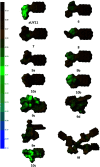Ramified derivatives of 5-(perylen-3-ylethynyl)uracil-1-acetic acid and their antiviral properties
- PMID: 35531032
- PMCID: PMC9070374
- DOI: 10.1039/c9ra06313g
Ramified derivatives of 5-(perylen-3-ylethynyl)uracil-1-acetic acid and their antiviral properties
Abstract
The propargylamide of N3-Pom-protected 5-(perylen-3-ylethynyl)uracil acetic acid, a universal precursor, was used in a CuAAC click reaction for the synthesis of several derivatives, including three ramified molecules with high activities against tick-borne encephalitis virus (TBEV). Pentaerythritol-based polyazides were used for the assembly of molecules containing 2⋯4 antiviral 5-(perylen-3-ylethynyl)uracil scaffolds, the first examples of polyvalent perylene antivirals. Cluster compounds showed enhanced absorbance, however, their fluorescence was reduced due to self-quenching. Due to the solubility issues, Pom group removal succeeded only for compounds with one peryleneethynyluracil unit. Four compounds, including one ramified cluster 9f, showed remarkable 1⋯3 nM EC50 values against TBEV in cell culture.
This journal is © The Royal Society of Chemistry.
Conflict of interest statement
There are no conflicts of interest to declare.
Figures






Similar articles
-
Compounds based on 5-(perylen-3-ylethynyl)uracil scaffold: High activity against tick-borne encephalitis virus and non-specific activity against enterovirus A.Eur J Med Chem. 2019 Jun 1;171:93-103. doi: 10.1016/j.ejmech.2019.03.029. Epub 2019 Mar 16. Eur J Med Chem. 2019. PMID: 30909022
-
5-(Perylen-3-ylethynyl)uracil as an antiviral scaffold: Potent suppression of enveloped virus reproduction by 3-methyl derivatives in vitro.Antiviral Res. 2023 Jan;209:105508. doi: 10.1016/j.antiviral.2022.105508. Epub 2022 Dec 26. Antiviral Res. 2023. PMID: 36581049
-
5-(Perylen-3-ylethynyl)uracil Derivatives Inhibit Reproduction of Respiratory Viruses.Russ J Bioorg Chem. 2020;46(3):315-320. doi: 10.1134/S1068162020030139. Epub 2020 Jun 20. Russ J Bioorg Chem. 2020. PMID: 32834709 Free PMC article.
-
Tick-borne encephalitis in Europe and Russia: Review of pathogenesis, clinical features, therapy, and vaccines.Antiviral Res. 2019 Apr;164:23-51. doi: 10.1016/j.antiviral.2019.01.014. Epub 2019 Jan 31. Antiviral Res. 2019. PMID: 30710567 Review.
-
Tick-Borne Encephalitis Virus: A Structural View.Viruses. 2018 Jun 28;10(7):350. doi: 10.3390/v10070350. Viruses. 2018. PMID: 29958443 Free PMC article. Review.
Cited by
-
Antiviral Activity of N1,N3-Disubstituted Uracil Derivatives against SARS-CoV-2 Variants of Concern.Int J Mol Sci. 2022 Sep 5;23(17):10171. doi: 10.3390/ijms231710171. Int J Mol Sci. 2022. PMID: 36077564 Free PMC article.
References
-
- Korshun V. A. Manasova E. V. Balakin K. V. Malakhov A. D. Perepelov A. V. Sokolova T. A. Berlin Y. A. Nucleosides Nucleotides. 1998;17:1809–1812. doi: 10.1080/07328319808004718. - DOI
- Skorobogatyi M. V. Malakhov A. D. Pchelintseva A. A. Turban A. A. Bondarev S. L. Korshun V. A. ChemBioChem. 2006;7:810–816. doi: 10.1002/cbic.200600040. - DOI - PubMed
-
- Andronova V. L. Skorobogatyi M. V. Manasova E. V. Berlin Y. A. Korshun V. A. Galegov G. A. Russ. J. Bioorg. Chem. 2003;29:262–266. doi: 10.1023/A:1023936516589. - DOI - PubMed
- Skorobogatyi M. V. Ustinov A. V. Stepanova I. A. Pchelintseva A. A. Petrunina A. L. Andronova V. L. Galegov G. A. Malakhov A. D. Korshun V. A. Org. Biomol. Chem. 2006;4:1091–1096. doi: 10.1039/B516804J. - DOI - PubMed
- St. Vincent M. R. Colpitts C. C. Ustinov A. V. Muqadas M. Joyce M. A. Barsby N. A. Epand R. F. Epand R. M. Khramyshev S. A. Valueva O. A. Korshun V. A. Tyrrell D. L. J. Schang L. M. Proc. Natl. Acad. Sci. U. S. A. 2010;107:17339–17344. doi: 10.1073/pnas.1010026107. - DOI - PMC - PubMed
- Orlov A. A. Chistov A. A. Kozlovskaya L. I. Ustinov A. V. Korshun V. A. Karganova G. G. Osolodkin D. I. Med. Chem. Commun. 2016;7:495–499. doi: 10.1039/C5MD00538H. - DOI
-
- Schang L. M. Future Virol. 2014;9:283–299. doi: 10.2217/fvl.13.130. - DOI
LinkOut - more resources
Full Text Sources

